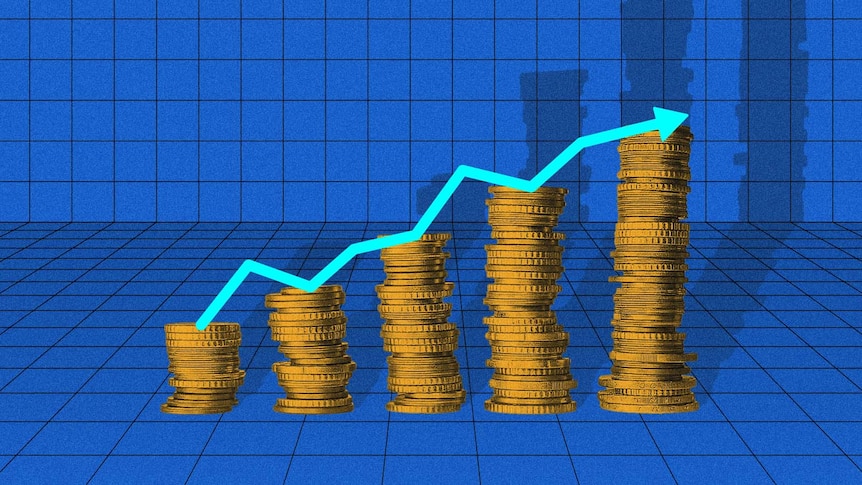WHAT DO YOU THINK!?!
Australia soon to be second in world for retirement savings as superannuation pool soarsBy business reporter
Daniel ZifferWed 2 AprWednesday 2 April

Australians have more than $4 trillion in superannuation assets. (ABC News: Emma Machan)
Link copied
Millions. Billions. Trillions — the dollars held by Australian workers in superannuation can make you dizzy.
"There's $4.2 trillion of members' money under management in superannuation," says Mary Delahunty, chief executive of peak body the Association of Superannuation Funds of Australia (ASFA).
'That makes Australia one of the top investors in the world."
ASFA's
new study suggests compulsory super has boosted household savings by more than $500 billion since its inception, and it is reducing the government's need to pay for the age pension — the main income support for older people.
ASFA says we're also spending vastly less than many other countries to give people a better retirement.
Australia currently spends around 2.3 per cent of our GDP on the aged pension, but that figure is falling (gross domestic product is the value of all the goods and services created in a year).
"It'll go down to around 2 per cent by 2060," says Ms Delahunty.
"This is against a backdrop of an aging population with increased health needs.
"It's bucking the trend internationally. Most OECD countries are [spending] 9 per cent and growing, and they will be above 10 per cent by 2060."

Mary Delahunty says superannuation has transformed the lives of workers. (ABC News: Simon Tucci)
The only country spending a smaller portion of GDP on the age pension currently is South Korea (1.3 per cent) but by 2060, that's predicted to be 7.5 per cent.
"We are the only ones going in the other direction … and it's the compulsory super system that has delivered that to every taxpayer."
The super system isn't without its costs, however.
According to the
latest federal budget, in 2024-25 alone, tax concessions on superannuation contributions cost the government $29.2 billion in revenue forgone.
Tax concessions on super earnings cost $22.2 billion in revenue forgone, and other miscellaneous concessions cost $3.8 billion.
But ASFA says when the cost of those super tax concessions is added to age pension costs, the total cost to government "is still relatively low and sustainable."
It says the cost of tax concessions for contributions is projected to remain stable at around 0.9 per cent of GDP, while the cost of concessions for investment earnings is projected to rise from 1 per cent, to 1.5 per cent of GDP by 2062-63.
Do Australia's super tax concessions take from the poor and give to the rich?Photo shows Three piggy banks sit in a row in white, pink and blue on a pink background. Their snouts are of differing shapes.

Australia's super tax concessions will cost the government almost $60 billion in 2025-26, which is $9 billion more than expected. How can we afford it?
"Overall, the total cost of the age pension and tax concessions for superannuation is projected to rise marginally — from 4.2 per cent of GDP to 4.4 per cent of GDP by 2062-63," it says.
"This is remarkable given the expected ageing of Australia's population. This means that the cost of Australia's retirement income system will remain more affordable than almost every other OECD country."
Sam Sicilia, chief investment officer at super fund HostPlus, said the primary purpose of super is to provide people with "dignity in retirement", but noted another intention was to reduce the reliance on the government age pension.
"What you'll find is, as account balances grow over time, in the future there will be less relying on government pension, and therefore it will reduce the burden on the taxpayer."
And there is only one size for super: bigger.
From July this year, 12 per cent of the value of all the pay packets in Australia will go into the superannuation system annually, locked up until people retire or turn 65 and can access it.
Megamoney as funds look globally to investThe amount of money in super is hard to comprehend — total superannuation assets were $4.1 trillion at the end of the September 2024 quarter,
according to ASFA.
Cath Bowtell, chair of IFM Investors, puts it simply: "That's just a lot of money."
IFM Investors represents so-called "industry", or profit-to-member, funds like AustralianSuper, HESTA and Rest, funds including AMP and Zurich that manage people's accounts for profit, as well as institution-based corporate funds such as Qantas Superannuation Plan and Telstra Super.
It looks after $230 billion in assets, from a 250-kilometre toll road in Indiana in the US, to container port terminals in Vancouver (Canada) and Adelaide, Perth and Darwin airports.
"There's $US2 billion ($3.2b) flowing into the [super] system every week that we have to invest.
"That's just a lot of money that has to be put to work for Australian working people and we have to scour the world, now."


Australia's massive superannuation pool
The country's largest fund, AustralianSuper, has more than 40 staff in New York.
Last year, Australian Retirement Trust opened an outpost in London, while Aware Super already had an office in the UK's financial hub.
"The size of the system [currently] is 1.5 times the size of the Australian economy, growing to two times the size of the Australian economy in the foreseeable future," Ms Bowtell notes.
Sam Sicilia agrees most Australians wouldn't understand the epic scale our system has grown to.
"We currently have the fourth-largest pension pool of capital in the world," he says, with only the US, the United Kingdom and Canada ahead.
"The Australian system is mandatory, and it will surpass the UK and Canada within the next five to seven years, so we will end up being the second-largest pool of capital in the world."
We'll have the silver medal for retirement savings, with just approximately 8 per cent of the population of the United States.
Big funds, not even taking into account more than 621,000 self-managed super funds holding more than $1 trillion, currently hold 21 per cent of the shares trading on the Australian stock exchange.
The funds could easily afford all Australian stocks, but instead spread their risk across different financial instruments and assets like land, office towers and toll roads.
That scale is raising big questions about our financial system.
Super's ability to amplify and dampen shocksIn its recent
Financial Stability Review — a bird's-eye look at the resilience and stability of our financial system — the Reserve Bank of Australia called out the scale of super.
"The superannuation sector's significant growth, rising connectedness with banks and increasing footprint in financial markets creates new risks, including the ability to amplify shocks."
As the sector has grown, its connections with the banking system have increased: superannuation funds directly hold nearly one-third of bank short-term debt securities and over one-quarter of equity issued by domestic banks.

Australian super funds provide a huge amount of the funding for domestic banks. The RBA says that's both a source of stability and a potential risk. (Supplied: ASFA)
"Consequently, superannuation funds have the potential to amplify shocks in the financial system," the report says.
This could happen if the investment decisions of funds were to become "more correlated or concentrated in times of generalised market stress".
This did happen at the start of the COVID-19 pandemic, when funds increased their sale of banks' "debt securities" back to those same banks, which added to the pressure they were under to find funding. It made finding cash more expensive.
What does 'slow motion sell-down' mean for super?Photo shows Blurred numbers on the ASX stock boards

The Australian share market is now close to what financial market participants call a "technical correction".
But the flip side is that a key tenet of superannuation is the concept of "preservation" of money for retirement.
Because people generally can't access their super until they hit 'preservation age' or turn 65, when there are market downturns there isn't a surge of people removing all their money from their super accounts, because they're not allowed to. (There are exceptions,
such as people who were allowed to access a portion of their funds during the pandemic.)
That means superannuation funds are still searching for investments when others flee.
"As long-term investors, superannuation funds can support financial stability by deploying capital in a counter-cyclical manner, including when volatility spikes and asset prices fall," the report adds.
Because super funds are investing for a long horizon and most customers can't pull their money, market dips are an opportunity to buy assets at a cheap rate rather than a disaster that sees customers lining up to withdraw their cash at a loss.
The sector is also structured in a way that "help
limit the build-up of systemic risks", including by having variable returns, it notes.
Super a 'patient provider of capital', industry says
The super industry, predictably, doesn't see its size as a weakness.
ASFA's Ms Delahunty says the "interconnectedness of super with the banking system and other financial systems around the world" is something the sector has been watching closely — and is one of the key reasons funds diversified into investing in different things in different parts of the world.
"We invest in Australia and increasingly, invest internationally, and we work pretty closely with the central bank on what some of those risks might be," she says.
"On the flip side of that stability is this patient provider of capital that actually can invest counter-cyclically as well. So it is an argument with two sides of a coin, I suppose."
HostPlus's Sam Sicilia says Australia's "four very strong, very stable banks" served the nation well during the pandemic and added to financial stability. But they weren't alone.
"The superannuation funds had capital, and now have arguably more capital to provide a backstop in case there is a financial event," he told ABC News at the Asia Pacific Financial and Innovation Symposium in Melbourne.
"We can fund companies, we can fund investments. We could fund banks to help them through liquidity needs in the event of a crisis … a large pool of capital provides stability to the financial system."
Super funds searching for liquidity
Deutsche Bank macro strategist Lachlan Dynan says the scale of Australian superannuation investments means that, in many ways, they've "outgrown" the options here. !
$19.80
!
$19.80
 (20min delay)
(20min delay)




